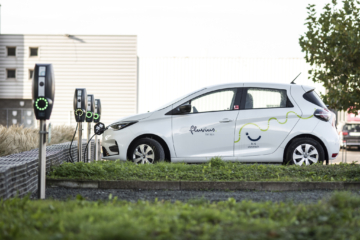Electric on the road with Fluvius

We all have to start driving 'greener'. That is a given. Fluvius wants to contribute as well and is taking many steps to support electric driving.
We all have to start driving 'greener'. That is a given. Fluvius wants to contribute as well and is taking many steps to support electric driving.
Fluvius is actively working towards a climate-neutral society and wants to help achieve the European climate objectives. The European Union aims to be climate neutral by 2050, with an economy that does not emit greenhouse gases. One of the actions is the greening of the vehicle fleet.
One million Flemings driving electric by 2030
Sales of electric cars are already on the rise: it is predicted that by 2030 one million Flemings will be driving around in an electric car. Fluvius is committed to making all of Flemish passenger transport electric by 2050.
How do we do that?
- Capacity: Anyone with an electric car wants to be able to charge it at all times: at home or in the neighbourhood, at work or on the road. As network operator we ensure that this is and remains technically possible: a specialized tool monitors our networks and makes simulations about the impact of more electric cars. In this way we are constantly keeping our finger on the pulse. Today the Flemish electricity network has sufficient spare capacity to charge large numbers of electric cars simultaneously.
- Advice: We advise you to charge your electric car in a smart way in order to avoid additional peak moments on our grids. We reinforce this advice with specific contract and tariff initiatives, such as the capacity tariff. This will make it more advantageous to spread your consumption in 2022. The digital meter will help you do this.
- Investments: To guarantee the necessary capacity in the future, we will make additional investments in the distribution networks between 2020 and 2050.
- Voltage change: Are you connected to a 230-volt grid at home, but you need 400 volts to charge your car more quickly? You can ask us for a voltage change at a reduced rate.
- Charging points: The Flemish government wants to install some 30,000 additional (semi-)public charging points in cities and towns by 2025. We help with advice on the choice of locations and the connection of the poles to the grid.
- Guidelines: In consultation with all the partners involved, we have prepared a series of guidelines to facilitate the installation of charging stations in apartment buildings and garage boxes.
Latest insights & stories

A Global Movement: The World Unites in a Pink Pledge for Clean and Sustainable Water
5,000 participants. 32 countries. €30,000 funds raised. And that's just the beginning.
Picture this: One step that sends ripples across the globe, transforming lives and creating waves of change. You might wonder, how can such a simple action for most of us have such a profound impact?

Sustainability and circularity in construction
Join us in transforming the future of construction, creating buildings that not only stand the test of time but also contribute to a healthier planet!

RainTunes: Shower scenarios for the soul
Light, hearing, smell, and touch: Together with experts, we have developed sensuous scenarios that turn showering into an individual experience. Whether you want to prepare for the day ahead or relax after working out. Whether you want to refresh after a day’s work or unwind at the end of the evening: RainTunes surprises with multisensory experiences.*
*Currently available only in Germany and Austria.